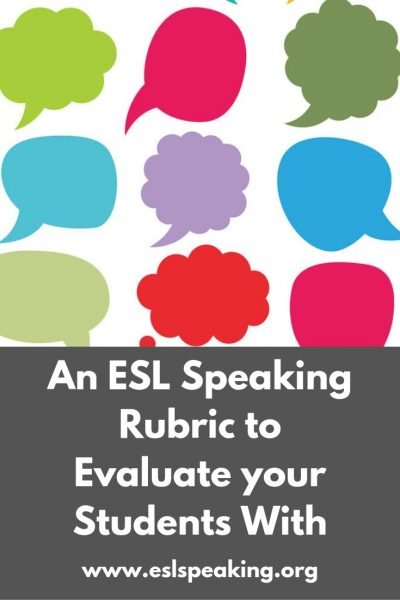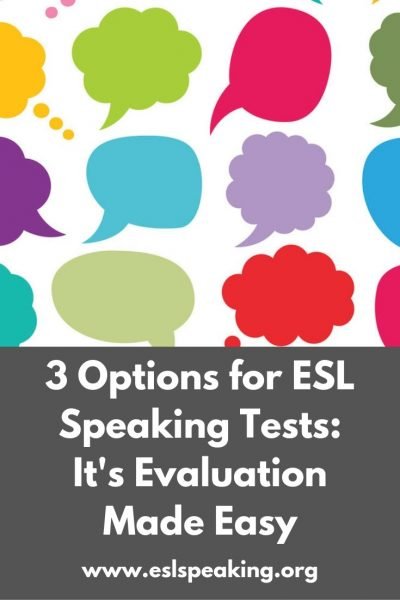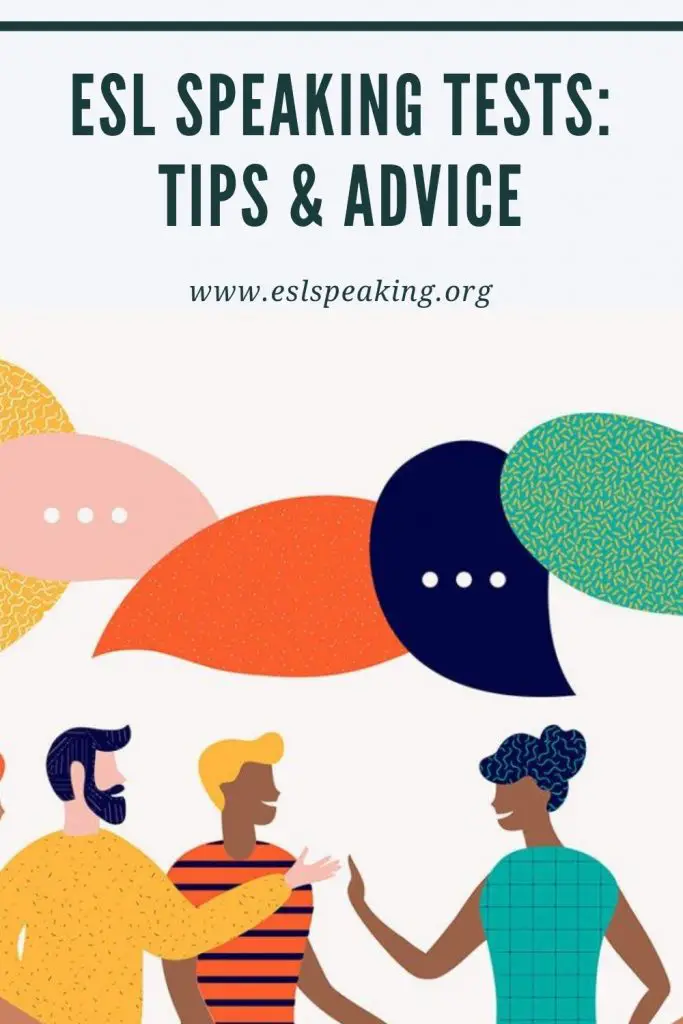If you want to find out about an ESL speaking rubric, you’re in the right place. I have everything you need to know about ESL rubrics, along with ideas for ESL speaking tests. Keep on reading for all the details about ESL speaking rubrics to evaluate students easily and fairly.

Speaking Rubric ESL
This speaking rubric for ESL is appropriate for a conversation between two students, but not for a presentation or speech style of test, or conversation with the teacher. It’s also not an appropriate way to evaluate the reading, or writing skills, although it does touch on listening.
For a more formal assessment, have a look at this one: IELTS Speaking Evaluation.
Speaking Rubric ESL: Everything You Need to Know
Here are some of the most important factors to keep in mind when evaluating speaking for your English learners. Keep on reading for more details about:
- Simple vs complicated
- Grammar + vocabulary
- Interesting, detailed answers
- Quality of questions
It works well with elementary school students to college students or adults. And it’s quite a helpful framework for cutting through all the confusion and being able to simply separate the top students from the weaker ones. You can also get away from looking simply for errors into rewarding students who go above and beyond that.
Simple vs Complicated ESL Speaking Rubrics
There are also a million and one ways to evaluate speaking tests with an ESL speaking rubric. However, I always prefer the simple way for just about anything, especially with language learners.
If you look on the Internet, you’ll notice that lots of other people have talked about this before. But, a lot of the other ESL speaking rubrics you see are so complicated that I don’t think their students will actually understand them.
I’d rather make it simple, and easy to understand for my students. I want them to know how to get a good score on the test when they’re studying for it. It just seems fair.
I have three categories in my ESL speaking rubric, and each one is worth an equal number of points.
Quick teaching tip for grading: If your speaking test is worth 30% of the final grade, make each category worth 10 points! Or, if you’ve allotted 15% for it, make each category out of 5 points.
It’ll save teachers a ton of time at the end of the semester. Plus, your students will be able to add up their own scores really easily this way.
ESL Speaking Rubric: 3 Sections
Let’s get to the three categories in my ESL Speaking Rubric.
- Grammar and vocabulary (10 points)
- Interesting, detailed answers (10 points)
- Good questions (1o points)
It’s not just useful for English tests but could be applied to any foreign language.

ESL Speaking Test Rubric
#1: Grammar and Vocabulary
This section does not cover all vocabulary and grammar possible in the English language, but only what we studied in class up to that point. For example, if we’ve been studying the passive voice I’d expect students to use that, when appropriate for the topic.
Including ALL English grammar and vocabulary isn’t really fair, especially for beginner-level students.
If we’ve been studying about laws and punishment, I’d expect students to use vocabulary terms like jaywalking, shoplifting, life sentence and parole in their answer, if appropriate. Simple words or talking around these words by describing them but not actually saying them would result in a deduction.
For example, using “walking across the street, not at the correct place” would be considered incorrect if I’ve clearly taught “jaywalking” in class. Students know to expect this so it’s not a surprise to them!
I also include other very simple, basic things that students at their level would be expected to have down cold. For example, high-intermediate students should have a very firm grasp on using the simple past and not make mistakes, even though we may not have explicitly studied it.
Absolute beginners require special consideration for this because they usually have no English skills beyond what you’ve taught them. In this case, I stick almost exclusively to what they’ve studied in my class.
1 Example
Talking around these things will result in a lower score. For example, saying something like, “Crossing the street at the wrong place,” instead of just saying the vocabulary word we’ve studied (jaywalking) will result in a deduction.
When you’re explaining the test, be fair and give plenty of examples about this so students are clear that you expect them to use the appropriate vocabulary terms.

ESL Speaking Rubrics
#2: Interesting, Detailed Answers
This means that students should not just give very simple answers to their partner, but should elaborate with one or two extra details. I encourage this is in class every single day, so a failure to do this on the test does not make me happy!
Have the students actually thought about the topics and subjects discussed, and aren’t just giving answers straight out of the textbook? Yes? Great. No, you won’t score that highly on this section.
Basically, is it easy to have a conversation with this student, or not. The best students will find it very easy to get a perfect score in this section.
1 Example
For example, if a student asks the question:
Q: What do you think is a big problem facing students in Korea these days?
A: Maybe cell-phone addiction.
This answer would result in a very low score. They should have elaborated with 1-2 supporting details. Or, even a follow-up question to their partner would have been okay.
As it is, the burden is on their partner to keep the conversation going.
That said, I always tell students that 1-2 details is enough. Nobody likes having a conversation with someone who won’t stop talking!
#3: Interesting Questions
This involves actually listening to their partner and asking appropriate follow-up questions in order to keep the conversation going.
It also involves thinking of an interesting way to start the conversation, since I just give them very general topics but leave the actual conversation starter up to them. Since I give my students the topics a couple weeks before the test, there’s almost no excuse except laziness to not have an interesting conversation starter!
I always give plenty of ridiculous examples when I’m explaining the test about all kinds of terrible follow-up questions. It’s funny, but it seems to work and most students do quite well in this section. Students are free to ask any sort of question they want to follow-up on something, but it has to match the answer.
1 Example
Q: What’s a big problem facing students in Korea these days?
A: I think student debt. Lots of families can’t afford to pay for university anymore, so students have to take on debt. But, it’s a big burden when they graduate because they can’t save money for a house.
Q: So, what about cell-phone addiction?
This is a terrible follow-up question. The second student gave quite an interesting answer, but the first student didn’t even listen to it.

ESL rubrics for speaking
ESL Speaking Test Evaluation Paper
The paper that I use to log scores is super simple. You can see it below:
Name:
ID#:
Grammar + vocabulary 1 2 3 4 5
Interested, detailed answers 1 2 3 4 5
Good Questions 1 2 3 4 5
Comments:
Should My Lesson Plans Reflect this Speaking Rubric ESL?
That’s a great question and I’m happy you want to know! I’ve seen all kinds of things over the years. For example, a teacher who spends much of their conversation class time focusing on listening or reading, but then tests exclusively on English language speaking.
Or, another teacher who spends the majority of the class time on free-talking, but then requires a presentation for the final exam. To me, these two examples seem to be a major error in teaching methodology.
I prefer to focus my lesson plans on what I’ll be testing on. Because I test conversational English between students, most of the activities in the class are a reflection of this.
Of course, I don’t teach to the test as there’s no standardized test and I get to design my own. However, the students perceive the test as being more fair, and the class overall as better if you test what you’ve been teaching for the most part.
When Do Students Get to See Their Speaking Test Scores?
I’ll generally show the students their scores right after they’re done with their tests. I’ll make a point to privately show them their score because it’s certainly nobody else’s business! But, then I’ll make my comments to them in front of the other students.
I find that this works well if students have questions or want to challenge their scores. It’s impossible to remember exactly what happened a week or two later when you have 100+ students or even 20 of them for that matter!
I generally provide a ton of feedback at the midterm exam so that students have a chance to learn from their mistakes and improve their scores for the final exam.
Here’s Another ESL Speaking Rubric for Language Learners
Don’t like this one? Here’s another one that you might want to try out. All of these categories are equally weighted:
- Clarity (Are the questions and answers clear and comprehensible?)
- Correct Pronunciation (ranging from native speaker life to incomprehensible)
- Fluency (how quickly the student asked and answered questions)
- Comprehension (whether or not the student understood the questions, and was able to give appropriate answers)
- Content (very simple, to quite detailed answers). This is closely related to task completion.
This one is very simple and it wouldn’t be a case of information overload when you tried to explain it to the students.
And One More Grading Rubric for English Speaking
Here’s another one you might want to consider. All the categories are equally weighted.
- Vocabulary
- Grammar
- Fluency
- Interactive communication
- Pronunciation
This one is also quite simple and understanding the test wouldn’t be a problem for almost all the students.
What about Technology for Testing Speaking?
There are some teachers who like to make use of technology when grading English speaking. For example, they’ll record all the conversations and then refer back to them later. Or, they’ll record videos. When testing languages, particularly speaking, things can happen so fast and the teacher may wish they had more time to process things.
I don’t personally do this because I find it adds a layer of complication to it. What if your recording device isn’t working, or runs out of batteries half way through? What if you think you’re recording but actually aren’t? The possibility for disaster is quite high!
I find that it’s easy enough for most teachers to evaluate on the fly if they’re not actually engaging in the conversation. However, if you’re the conversation partner as well as evaluator (as opposed to just an observer), it can be quite tricky. It’s like your doing two functions instead of just one and it is sometimes not that easy to do.
My School Assigns an ESL Rubric: Do I Have to Use It?
Some schools allow a huge degree of freedom with regards to this, while others are specific in how they want students to be tested. Both of these situations have their advantages and disadvantages.
However, if your school requires you to use a specific rubric, then use it and don’t have a second thought about it. No matter which one you use, it’s likely to reward the best English speakers with the best grades and vice-versa.
What is ESL Assessment?
ESL assessment can happen informally throughout the course and it allows teachers to track the ongoing progress of their students. It’s also known as authentic or alternative assessment. On the other hand, standardized ESL tests measure student’s abilities at a particular point in their English learning journey. Both are useful for ESL students.
3 Options for an English-Speaking Test

Speaking tests for ESL students
There are various ways for language teachers to do an ESL speaking test, all of which have their positives and negatives. Some are easier on the teacher and some are more difficult. Some are more accurate, while others are less so.
What you choose for an English speaking test really depends on your personality and the amount of time you have to administer your tests and the number of students. Keep on reading for some ESL speaking test questions, along with tips and tricks for doing these kinds of tests the better way.
I will give only the most basic of overviews of three different English speaking test methods for English as a Second Language students. If you want to dive deeper into the topic, I recommend this book: Language Assessment: Principles and Classroom Practices (2nd Edition).
ESL Speaking Test #1: 1-1 Interview with the Teacher
The 1-1 interview with the teacher method is generally thought to have the highest validity, since weaker students cannot affect the stronger students in any way. However, I think there are more negatives than positives:
- The power dynamic which can come into play
- The necessity to have students, alone in an office or classroom. This is something that I’ll always try to avoid if possible.
- Exhaustion on the part of a teacher. It just simply takes a lot of time and mental energy. In some semesters, I’ve had upwards of 200 students. It’s just not feasible to test every single of them in a 1 week period.
- The teacher needs to serve as examiner and conversation partner, which can get tricky at times, especially at the end of a long day of tests. This is especially hard with the lower-level students who will often depend on you to to keep the conversation going.
ESL Speaking Test #2: Conversations and Role-Plays
Many English teachers get the students to conduct 1-1 conversations among themselves while the teacher just listens, observes and evaluates.
The big negative of this one is that a weaker student can affect a stronger student, and although the teacher accounts for this in grading, it can often be seen as “not fair” in the student’s eyes.
However, there are lots of positives to this 1-1 conversation between students:
- No power dynamics
- It can at least partly replicate “real” conversation, where the people are at a similar level of English ability.
- The teacher can just focus on listening and not have to act as a conversation partner.
- Students often feel less nervous with at least one other person in the room besides the teacher.
- It’s far less tiring than option #1 for the teacher because they only have to listen, not participate in the conversation.
Find out more details about how I conduct this kind of test with my students, and also how I prevent the “memorization” factor.
ESL Speaking Tests, Conversation Style

English speaking test evaluation styles.
ESL Speaking Test #3: Presentations
Presentations are perhaps the easiest on the part of the teacher to administer, especially in groups. You can “test” a group of 30 students in as little as a single 1.5 hour class.
The biggest negatives to presentations are that it doesn’t replicate “conversation” at all and this is most often what courses consist of at, especially at universities. But, if the teacher actually spends time teaching students how to do presentations, it can be a valuable life-skill that students can take with them throughout their lives.
If you do decide to teach and test students on their presentation skills, the best resource I recommend is: Speaking of Speech: Basic Presentation Skills for Beginners. I’ve taught presentations for years and have stuck with this book the entire time, with excellent results.
Presentations: I Don’t Use Them for Tests
I personally will have a “presentation day” (or two, depending on class size) in my courses. I make it a small percentage of the final grade (around 10%) and give students lots of freedom about group sizes (1-4), and topic (it can be anything in the news lately).
It usually ends up being one of the most interesting classes of the semester! But, I prefer not to do this for a test in a conversation class.
For more details about this, check out:
Current Events Presentation Project

ESL speaking questions
ESL Speaking Tests FAQs
There are a number of common questions that people have about ESL speaking, including tests and exams. Here are the answers to some of the most popular ones.
How can I evaluate ESL speaking?
There are a number of ways in which you can evaluate ESL speaking. Some of the most common ones (make a rubric) include pronunciation, accuracy, fluency, interaction and ability to communicate effectively. This is an important part of an ESL teaching philosophy.
How can I teach ESL students to speak?
If you’re trying to teach ESL students to speak, employ some of the following ideas:
- Focus on communication and fluency, not accuracy all the time.
- Have students study new vocabulary and key grammatical concepts.
- Use student-centred ESL activities and games.
- Do lots of pair and group work.
- Have as much student-talking time in classes as possible.
- Teach the difference between formal and informal English.
How do I pass an ESL speaking test?
If you’re trying to pass an ESL speaking test, here are some tips. First, make sure you know the format of the test because it varies from exam to exam. Secondly, brush up on your grammar and vocabulary. Finally, do lots of speaking practice, in the format of the test with a language partner or teacher.
How can I know my English speaking skills?
One of the best ways to know your English speaking skills is to take an English proficiency exam like the IELTS. Besides that, pay attention to what happens when talking to other people. Are they easily able to understand what you’re saying or not. And, do they give the expected answer or something else?
What is the World Language Presentational Speaking Rubric
The “World Language Presentational Speaking Rubric” typically refers to a set of guidelines or criteria used to assess and evaluate a person’s ability to deliver a presentation or speech in a world language (a language other than their native language). This type of rubric is commonly used in language learning and assessment contexts to evaluate students’ proficiency in speaking and presenting in a foreign language.
While specific rubrics can vary depending on the institution, educational level, and language being assessed, here is a general overview of what such a rubric might include.
Content and Organization:
- Clear introduction, main points, and conclusion.
- Well-structured content with logical progression of ideas.
- Relevant and accurate information presented.
Language Usage:
- Appropriate vocabulary and grammar for the level of proficiency.
- Varied and descriptive language to engage the audience.
- Correct and accurate use of tenses, verb forms, and sentence structures.
Pronunciation and Intonation:
- Clear pronunciation of words and phrases.
- Appropriate stress and intonation patterns for effective communication.
- Minimal interference from the speaker’s native language.
Fluency and Coherence:
- Smooth and uninterrupted flow of speech.
- Effective use of transitional phrases and connectors.
- Ability to handle unexpected questions or interruptions coherently.
Cultural Awareness:
- Demonstration of understanding cultural nuances and appropriate language use.
- Inclusion of culturally relevant examples and references.
Engagement and Audience Interaction:
- Maintaining eye contact and using appropriate body language.
- Engaging the audience through effective gestures and facial expressions.
- Encouraging questions or interaction from the audience.
Time Management:
- Staying within the allocated time limit for the presentation.
- Balancing the time spent on different parts of the presentation (introduction, main points, conclusion).
Creativity and Originality:
- Incorporation of creative elements such as anecdotes, visuals, or personal experiences.
- Presentation that stands out and captures the audience’s attention.
Overall Impression:
- Overall effectiveness of the presentation in conveying the intended message.
- The speaker’s confidence, enthusiasm, and engagement.
Do you like this ESL Speaking Rubric and ESL Speaking Tests?
- Amazon Kindle Edition
- Bolen, Jackie (Author)
- English (Publication Language)
- 187 Pages - 03/09/2016 (Publication Date)
Yes? Thought so. It really is super simple and easy to use this rubrci for all your English speaking classes.
If you need some more simple, easy ideas for your English classes, then you’re going to want to check out this book over on Amazon: 101 ESL Activities: For Teenagers and Adults. It’ll make your lesson planning easy, guaranteed.
Just open up the book to the section you’re looking for: speaking, writing, warm-ups, etc. and find an interesting and engaging activity or game to use in your classes. It’s easier than ever to vary your lessons and keep things fun.
You can check out the book for yourself over on Amazon. But, only if you want to get some ESL awesome going on.
It’s available in both digital and print formats. You can download the e-version onto any device with the free Kindle reading app. Yes, it really is that easy to have a ton of fun ESL activities at your fingertips for lesson planning at your favourite coffee shop.
Or, keep a copy on the bookshelf in your office as a handy reference guide. Check out 101 ESL Activities for yourself over on Amazon:
ESL Speaking Rubric: Have Your Say!
What do you include in your rubric for evaluating English speaking? Are there any notable things that you don’t include? How do you evaluate other subjects for ESL students?
Leave a comment below and let us know your thoughts. We’d love to hear from you.
And be sure to contact us with any questions you have about teaching English. Also be sure to give this article a share on Facebook, Twitter, or Pinterest. It’ll help other teachers, like yourself find this useful teaching resource.
Last update on 2025-04-09 / Affiliate links / Images from Amazon Product Advertising API








This looks great for a classroom setting. Thanks!
Do you have any suggestions for initial assessment of an ESL teenager who I will be tutoring one-on-one?